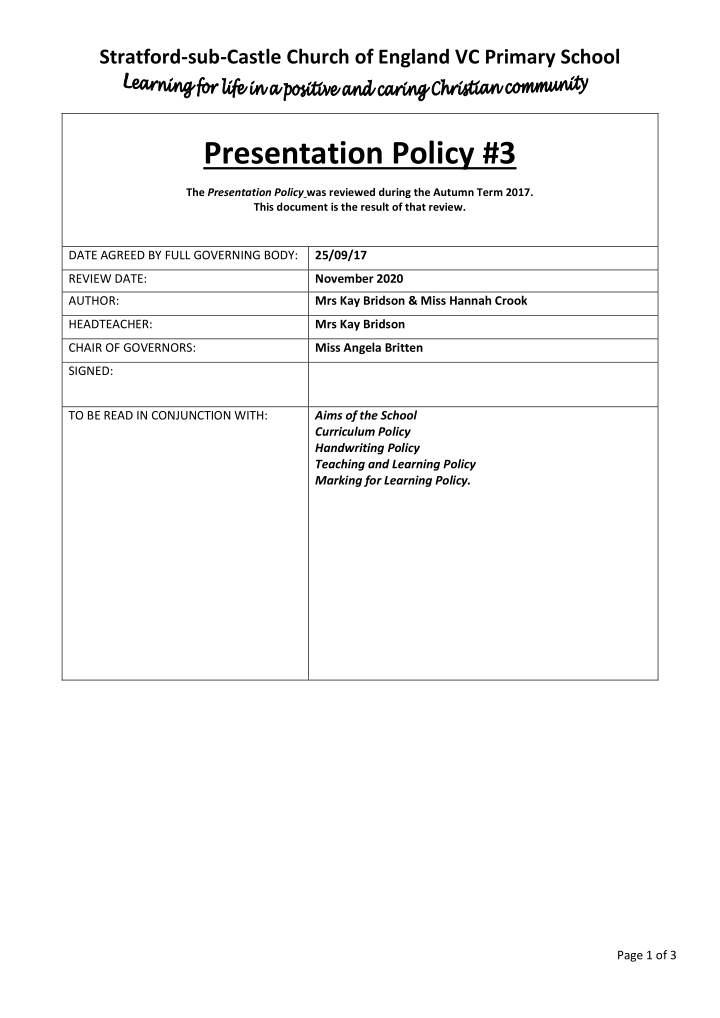



Stratford-sub-Castle Church of England VC Primary School Presentation Policy #3 The Presentation Policy was reviewed during the Autumn Term 2017. This document is the result of that review. DATE AGREED BY FULL GOVERNING BODY: 25/09/17 REVIEW DATE: November 2020 AUTHOR: Mrs Kay Bridson & Miss Hannah Crook HEADTEACHER: Mrs Kay Bridson CHAIR OF GOVERNORS: Miss Angela Britten SIGNED: TO BE READ IN CONJUNCTION WITH: Aims of the School Curriculum Policy Handwriting Policy Teaching and Learning Policy Marking for Learning Policy. Page 1 of 3
Stratford-sub-Castle Church of England VC Primary School Presentation Policy # 3 Purpose to fulfil the aims of the school through a consistent approach to presentation to raise standards of attainment. Statement of Aims to foster pride in and an awareness of aesthetic presentation of work to promote effective communication to promote positive self-image and high self-esteem to promote ownership of learning. Implementation The Headteacher has overall responsibility for the implementation, management and monitoring of the Presentation Policy . The day-to-day implementation of this policy is a shared responsibility. Statement of Principles We believe pupils should develop an awareness of the importance of clear, neat presentation in order to communicate effectively a balance between content, creativity and aesthetic quality must be struck within any piece of work a variety of learning styles should be catered for – unnecessary constraints should not be imposed upon children, creative responses being encouraged. Agreed Conventions A set of conventions for the presentation of work has been agreed. It is implemented throughout the school. DATE: Written on left hand of the page. Underlined with a ruler. Mathematics: 5/7/17, 05.07.17 (know alternatives) Written work: Monday 5 th July 2017. UNDERLINING: Write first, then under-line (under!); use a ruler for all straight lines. WALT (We Are Learning To): Move down from top line. Centre. Underline with a ruler. The WALT is the learning objective. DRAW: In pencil. COLOUR/SHADE: In pencil. (No felt-tips / gel pens, except highlighting!) WRITE: With an appropriate implement. Encourage choice and take account of learning styles and needs. Best work to be in pen, blue or black ink. English Books - generally in pen (note-taking may be in pencil), Mathematics Books - generally in pencil but writing may be in pen (e.g. when explaining thinking.) Page 2 of 3
Not every occasion warrants “best” writing. It is expected that children will write with a degree of care at an appropriate speed for most normal purposes so that their writing is legible and fluent and not too painstakingly produced. “Best” writing is reserved for those occasions when attention can be concentrated on the mech anical skills of writing and when there is a seen to be a clear purpose for producing aesthetically pleasing work. Children may use a pen (and be awarded their Pen Licence ) when their handwriting reduces to approx. 7mm and a cursive style is emerging. RUBBERS: Encourage the appropriate use of rubbers. (Mistakes are not mistakes they are learning opportunities, we want to see working out and value it highly) LINEGUIDES: Always used when writing on plain paper. GRIDS: One digit one box! NAMES: Children are asked to write their full names on work completed on paper. FRONT COVERS OF BOOKS: Full names, subject title, class name & year group date (e.g. September 2012). Books may have a smart and if possible relevant picture or pattern stuck on the front cover. STICKING IN PAPER: worksheets or any other additional pieces of paper are to be trimmed or folded with the least number of folds Handwriting Pre-pen skills are developed in the EYFS or as part of PLP targets as necessary. Handwriting books are not used. Children benefit from sensory activities or write in their usual books. We recognise that purposeful guided practice is essential. Handwriting lessons: build on what has gone before are short and focussed (drip-feed!) begin with a demonstration from the teacher – handwriting is a movement skill provide children with the opportunity to practise provide teachers with the opportunity to observe carefully and intervene with support and encouragement. Monitoring The effective implementation of this policy is monitored every half-term by the Headteacher, Deputy Headteacher and/or subject leaders. Page 3 of 3
Recommend
More recommend